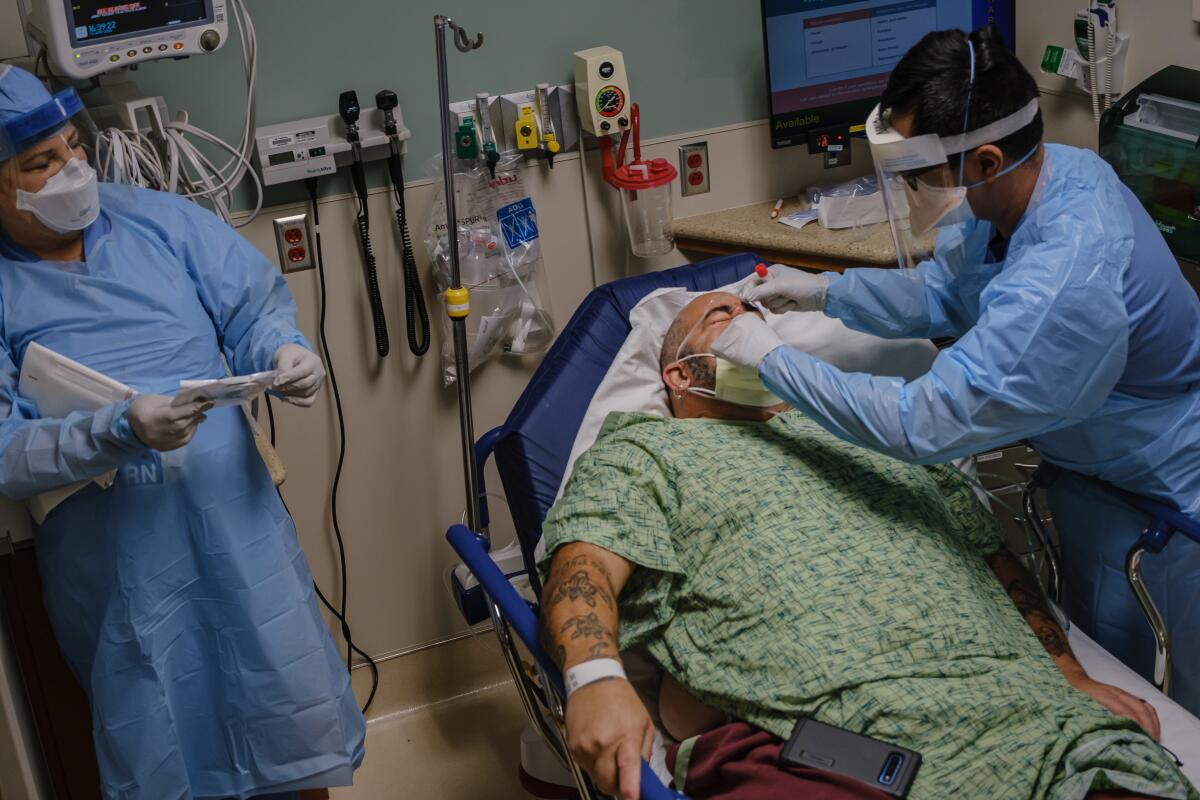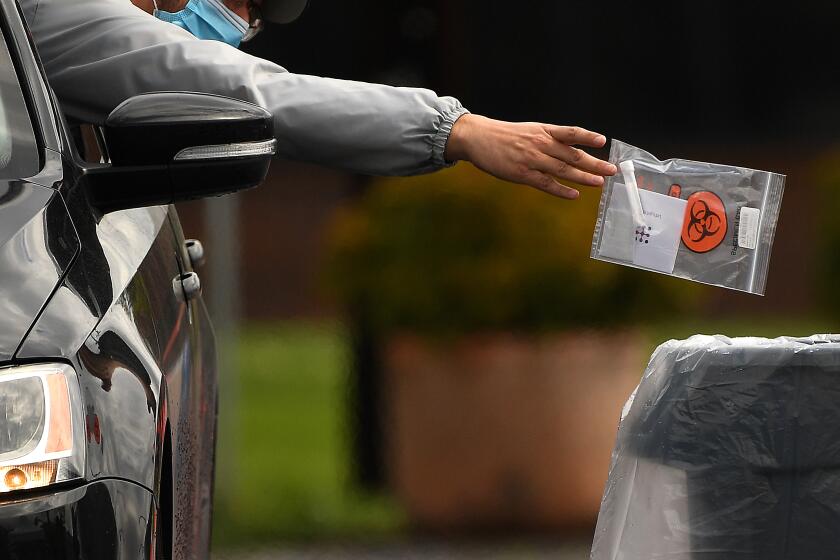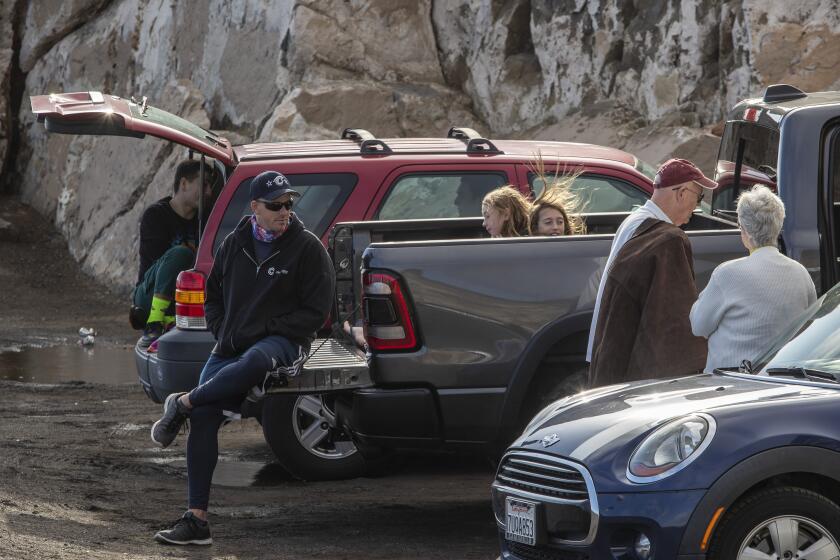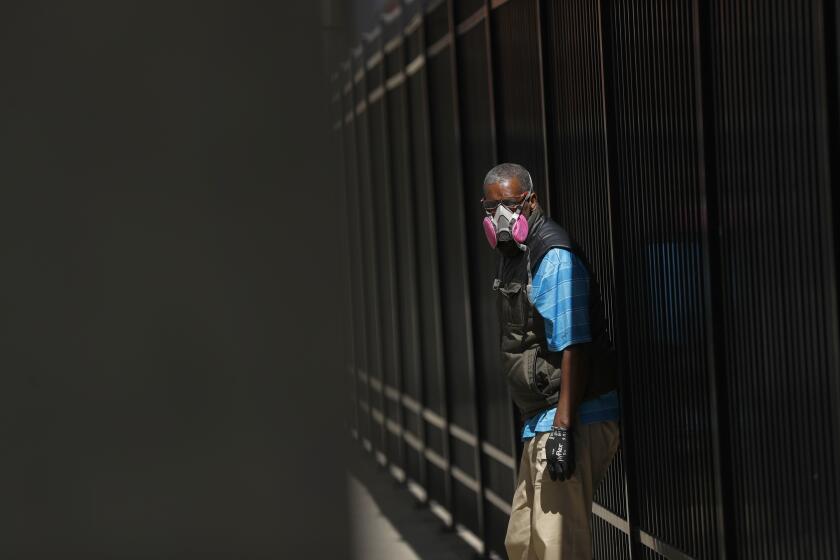‘Second wave’ of coronavirus could be far worse for California than the first, officials warn

- Share via
Even as California continues to bend the coronavirus curve, a rise in the number of COVID-19 cases and deaths as well as concerns about a second wave of the outbreak are reasons to stay vigilant, officials say.
California has recorded more than 37,000 cases, adding nearly 2,000 on Tuesday alone. Part of the increase in new cases this week is the result of a lag in labs reporting test results and releasing bulk numbers. More than 1,400 people have died across the state.
Gov. Gavin Newsom and others have said that California and the nation have not necessarily seen the worst of the coronavirus and that lifting stay-at-home rules could be disastrous.
“If we all pull back, we could see a second wave that makes this pale in comparison,” Newsom told CBS News. “I don’t anticipate that normalcy that many of us wish for happening anytime soon.”
California is now giving coronavirus testing priority to asymptomatic people in high-risk settings such as nursing homes and prisons.
Concerns about a second wave of coronavirus infections have been echoed by others.
“There’s a possibility that the assault of the virus on our nation next winter will actually be even more difficult than the one we just went through,” Centers for Disease Control and Prevention Director Robert Redfield told the Washington Post. “And when I’ve said this to others, they kind of put their head back. They don’t understand what I mean.”
Redfield said a second wave could be more devastating to the healthcare system if it came at the same time hospitals were dealing with flu cases.
Some California officials have pointed to the 1918 influenza pandemic, in which the second wave of illness was worse in some cities than the first.
“The really important lesson of 1918 is to keep interventions in place as long as possible,” Alex Navarro, assistant director of the Center for the History of Medicine at the University of Michigan, told The Times last week. “Because once the controls are removed, it’s very difficult to reinstate them.”
Both Los Angeles Mayor Eric Garcetti and San Francisco Mayor London Breed have cited that history in calling for caution.
Last week, Breed said she was well aware of the premature celebrations before the end of the 1918 contagion. She described how the illness “came back with a vengeance.”
With her eye on the present day, she added: “The fact is, it’s not over…. We will get through this. But it is going to require time, and it’s going to require patience, like never before.”
Officials this week are making a bid with Gov. Gavin Newsom to begin a slow and gradual reopening process, one they say is guided by science.
During a news conference Tuesday, Newsom called on Californians to remain cautious in order to protect one another as the numbers of deaths and hospitalizations continue to rise.
“We’re making progress in the state, but there was a spirit that defined that progress, and that was community,” he said. “If we pull back too quickly, those numbers will go through the roof.”
The governor told residents of communities that have been less affected by the virus to “disabuse” themselves of the idea that they are in the clear. He also said that several counties have reached out to ask about stay-at-home modifications, all with different proposed timelines, which he said he would be addressed Wednesday in the state’s update on its road map to reopening.
“This virus knows no jurisdiction,” the governor said Monday. “Different parts of this state [have been] impacted differently, but … the collective responsibility we have to one another, neighboring counties, neighboring cities, also must be considered.”
Newsom on Wednesday reemphasized that there are six key indicators for potentially modifying the stay-at-home order. Among those is increasing testing capacity, which he said “may be among the most important.”
Currently, the state can provide about 16,000 tests a day, he said, and the goal is to boost that to 25,000 a day by the end of the month.
He said the state is bringing 86 new testing sites online, which will be placed in more rural areas of the state and regions where they can serve “black and brown” communities.
“These sites will provide the kind of continuity that we need to ultimately advance our collective goals in this state to reach these testing goals,” he said, adding that their strategic deployment will “make sure we are truly, culturally competent in our testing.”
Newsom also announced that California hospitals can resume providing scheduled surgeries — which reflects confidence in the capacity of the statewide system. However, he emphasized that “we will be very thoughtful and judicious about how we do that. We will not overload the system.”
“We recognize that anytime we begin to toggle back and start opening things back up, we have to look every day at the data … to make sure that we are adjusting to these new decisions and maintaining an understanding that we need to be vigilant about the intended consequences of these decisions and the unintended consequences of these decisions,” he said.
Here’s an inside look with doctors and nurses on the frontlines of the COVID-19 battle.
Los Angeles County officials on Wednesday confirmed 1,318 more coronavirus cases, some of which were attributable to a backlog from laboratories that had not previously reported results through the county’s electronic system. Similar numbers had been reported the previous two days as well.
L.A. County officials continue to emphasize the need for residents to maintain social distancing practices after a study suggested that tens of thousands of county residents may have been infected with the virus. Without such efforts, that number would be far higher than the more than 16,000 cases that have been confirmed in the county of roughly 10 million people, officials say. More than 89,000 county residents have been tested for COVID-19, Public Health Department Director Barbara Ferrer said.
Los Angeles County’s stay-at-home order was previously extended to May 15, but Ferrer said that date is not a “magic number.” She noted that officials are relying on data and science and working with local hospitals to determine when to lift restrictions, and she asked residents to continue adhering to such directives until told otherwise.
“We have to take responsibly for 10 million people who live in L.A. County,” she said.
What do scientists wish they knew about the coronavirus? Which treatments actually work, what antibodies are good for, and which public health measures help.
Beginning Thursday, Garcetti said, all critical workers in Los Angeles, including those without symptoms, can get tested for the virus at county sites. Healthcare professionals, grocery store employees, first responders and critical government employees can get swabbed at any of the testing sites throughout the county, Garcetti said.
The expanded testing criteria, which the mayor said he hopes provide some peace of mind to workers, is also a critical milestone “on the road to reopening.”
During a news conference Wednesday evening, Los Angeles Police Chief Michel Moore thanked Garcetti, telling him that LAPD officers would no doubt be grateful to learn they could get tested.
“It’s great as a leader for me to know that,” the chief said.
The Los Angeles Police Department has 71 employees who have tested positive for the coronavirus, and the Fire Department has had 20 members test positive.
Twenty-five LAPD employees have recovered and returned to full duty, one individual is hospitalized, and all others are self-isolating at home and recovering. Fourteen LAFD employees have recovered and returned to duty, and six employees are isolating at home.
During his address, Moore urged victims of domestic violence to keep calling the police. Although calls to abuse hotlines are up across the nation, Moore said that his department is taking about 10 fewer crime reports a day stemming from domestic violence calls — a concerning juxtaposition, he noted.
“We’ll get you help,” Moore said, noting that the department can help victims get into shelters.
Moore also urged Angelenos to continue heeding orders to avoid beaches and trails, especially over the weekend, when temperatures are expected to get into the upper 80s and low 90s. Following those orders will not only save police the awkwardness of admonishing you, Moore said, but also would help Los Angeles reopen sooner.
Meanwhile, there is new evidence that the virus claimed its first California victims earlier than thought.
Two COVID-19 patients died in Santa Clara County on Feb. 6 and Feb. 17, the county medical examiner revealed Tuesday, making them the first documented coronavirus fatalities in the United States.
Until now, the first U.S. fatality was believed to have occurred in Kirkland, Wash., on Feb. 29.
Officials previously had said the first Silicon Valley death was March 9. But that was preceded by the two February deaths, and another person who died of COVID-19 on March 6, the Santa Clara County medical examiner said Tuesday.
Santa Clara County health officials identified the newly discovered first victim only as a 57-year-old woman who died at home, but The Times independently confirmed with relatives that the victim was Patricia Dowd.
Family members said that Dowd, who exercised routinely, watched her diet and took no medication, developed flu-like symptoms for a few days but then improved enough to start working from home. At 8 a.m. on the day she died, she was corresponding with a colleague; two hours later, her daughter found her dead at home, relatives said.
Dowd’s older brother, Rick Cabello, described his sister as a hardworking and caring person whose deep network of friends dated to her childhood and her high school years at St. Francis in Mountain View, where their family grew up.
“She was living the life she deserved,” he said.
Santa Clara County, the heart of Silicon Valley, was an early hotbed of the coronavirus outbreak. So far, it has reported nearly 2,000 cases and 94 deaths.
There have been growing suspicions that the new coronavirus has been in California longer than experts first believed.
Dr. Jeff Smith, the chief executive of Santa Clara County, said this month that data collected by the CDC, local health departments and others suggest the virus has been in California “a lot longer than we first believed” — most likely since “back in December.”
Ferrer agreed there was probably a gap between when the coronavirus first arrived in L.A. County and when the first infections were confirmed.
“We would anticipate that across the country, particularly in travel hubs like L.A. County is, we were probably seeing some infection much earlier on than we were able to diagnose,” she said Wednesday.
Despite evidence that the number of coronavirus cases appears to be stabilizing or declining in many nations in Western Europe, Dr. Tedros Adhanom Ghebreyesus, director-general of the World Health Organization, cautioned at a news conference Wednesday that the global pandemic is still in its early phases.
“Make no mistake: We have a long way to go,” he said. “This virus will be with us for a long time.”
Since the virus erupted in China in late December, 2.5 million cases of COVID-19 have been reported to the WHO, along with more than 160,000 deaths.
Tedros said there is no question that stay-at-home orders and other physical distancing measures have successfully suppressed transmission of the coronavirus in many countries.
More to Read
Sign up for Essential California
The most important California stories and recommendations in your inbox every morning.
You may occasionally receive promotional content from the Los Angeles Times.























